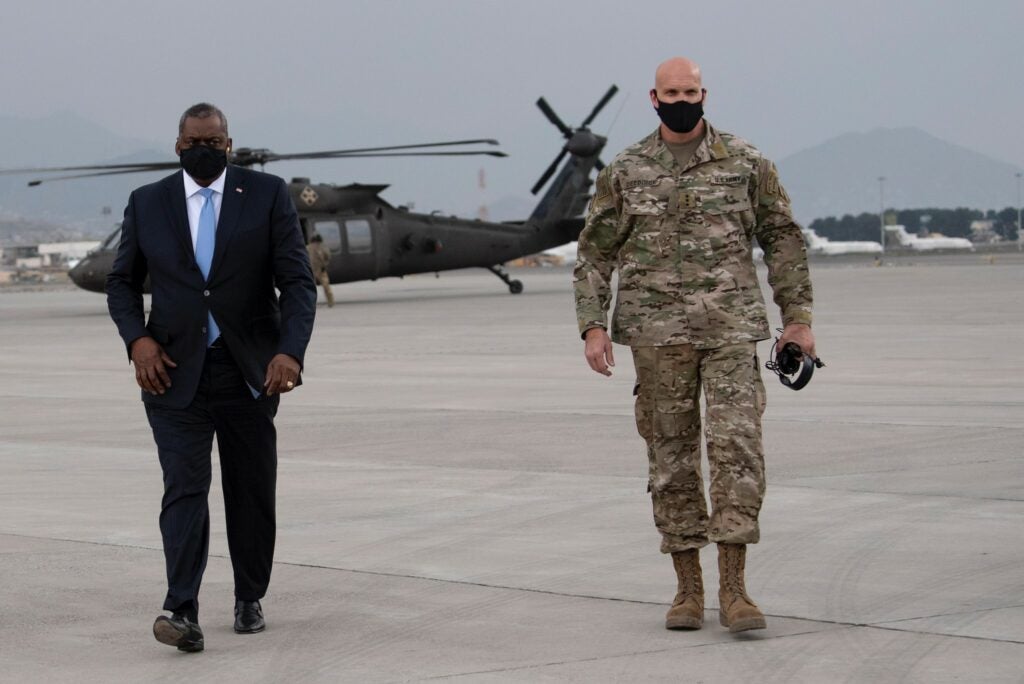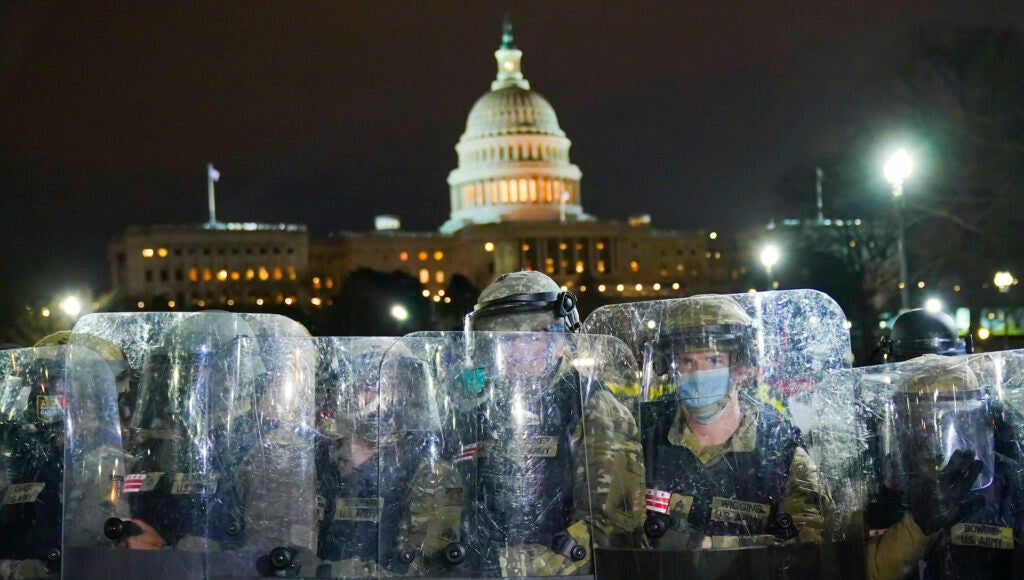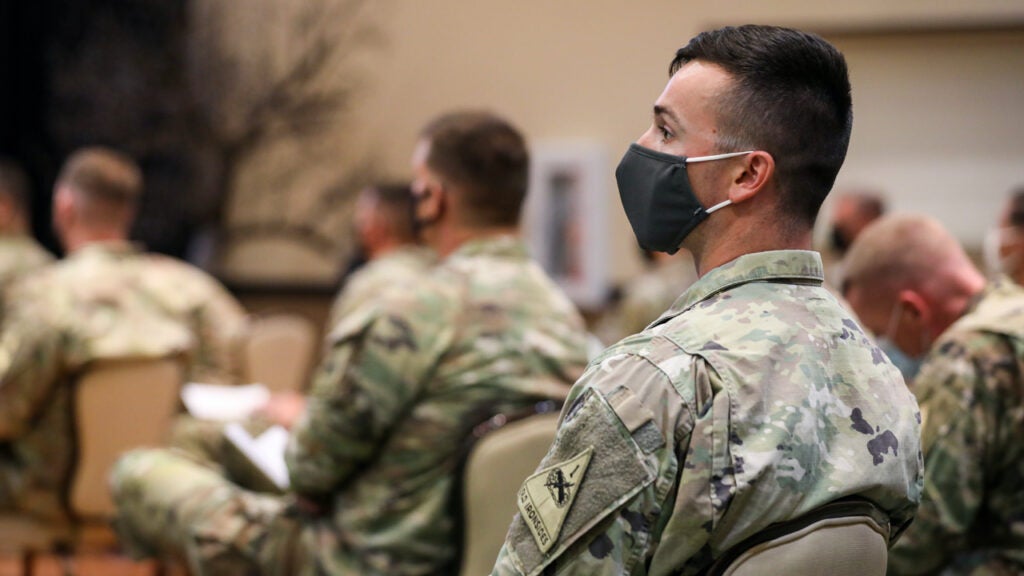
It only took a few months of being in the Army before one young Black soldier noticed racism in her unit.
She had just reported to her very first assignment after completing Advanced Individual Training. It was late on a Friday when she arrived at her installation and aside from what room to report to in the barracks, she didn’t have any other information — including what she needed to do next or where she could find the dining facility. So she dumped her bags in her room and decided to ask the soldier next door for help.
“She wanted to ask where she could get some chow, so she knocked on the room next door. The soldier opened the door and hanging right there on the back wall, in full view of the open door, was a white power flag,” a senior Army official said at the Pentagon on Friday. The official, who did not reveal the soldier’s name, recounted her story for his staff as part of the extremism stand-down directed by Defense Secretary Lloyd Austin, which ordered military leaders to hold frank discussions on how to identify and report extremism in the ranks, its impact on the mission, and what is and is not considered an acceptable activity or organization for service members to participate in.
“This is a young African American soldier,” the Army official continued. “She said it terrified her, she knew exactly what it meant. She knew precisely what that flag meant. She didn’t know what to do … she didn’t understand how that could be hanging in a barracks, in a soldier’s room, in 2021.”
Task & Purpose was invited to listen in on Friday’s conversation under the condition that participants be kept anonymous so they could speak freely and honestly about their experiences. The meeting, which included two senior Army officials and their staff, was just one of many that have been happening across the military in recent months.

“We will not tolerate actions that go against the fundamental principles of the oath we share, including actions associated with extremist or dissident ideologies,” Austin said in a Department of Defense-wide memo on Feb. 5. “Service members, DoD civilian employees, and all those who support our mission, deserve an environment free of discrimination, hate, and harassment.”
The memo came in the wake of the deadly Jan. 6 riot at the U.S. Capitol building carried out by supporters of former President Donald Trump. In the days following the riots, as authorities began bringing charges against those who were involved, NPR found that nearly one in five people charged were current or former military service members. According to CNN, two people arrested were in the Army Reserve and one was in the Army National Guard, in addition to 19 veterans of the Army, Air Force, Navy, and Marine Corps.
This month a former Army Special Forces soldier with more than 20 years of military service, who was working as a contractor for the State Department and Central Intelligence Agency up until 2018, was charged with allegedly assaulting four police officers during the Jan. 6 attack, Politico reported.
Still, the stand-down order was met with mixed reviews. Fox News personalities like Tucker Carlson and Laura Ingraham have scoffed at the idea as an example of the military becoming too “woke” and downplayed the importance of stamping out extremism, claiming that the stand-down “will do grave damage to our military preparedness.”
And while some service members told Military Times that it seemed their commanders were “brushing off questions” and simply trying to check something off their to-do list by having the stand-down, others had more positive experiences: A drill sergeant candidate at Fort Jackson, South Carolina, told Military Times it was “some of the best in-person training I’ve ever had.”
Yet even before the new defense secretary’s stand-down directive, the Army had made confronting racism and extremism in the ranks a top priority as the service shifted its focus from readiness and modernization to prioritizing its people. Senior leaders directed commanders across the Army to hold listening sessions with their soldiers to better understand their backgrounds and the challenges they’ve faced in both their military and civilian lives.
During Friday’s conversation, which was held over a video conference call to help maintain social distancing, a diverse group of enlisted soldiers and officers on the officials’ staffs chimed in with thoughts about extremism and how “active participation” in organizations — like actively recruiting others to join, distributing pamphlets about the organization’s priorities, or attending rallies in uniform — differs from freedom of speech.

What is extremism? According to DoD regulations, service members cannot actively advocate for ideologies or causes that encourage discrimination based on race, gender, religion, or ethnicity, and those that advocate for the use of force or violence to “deprive individuals of their civil rights.”
“Obviously attempting to overthrow the U.S. government by violence would be an example of an unacceptable behavior,” Acting Army Secretary John Whitley said during a video conversation on extremism with other senior leaders this month.
The senior officials kicked off the conversation on Friday by playing videos from Secretary Austin and senior Army leaders. Then officials brought up potential hurdles to identifying extremism, like a lack of knowledge about what certain flags or symbols might stand for.
“I would say my overall impression is we are not doing a good job educating the force on one, what represents extremist organizations, but two, of the organizations that are out there today, which are extremist?” said one senior official. “And what are those ideologies?”
But the officials made a point to clarify that the point of the conversation is “not about politics.”
“Whether you’re a Republican, a Democrat, a conservative, a liberal, an independent, or a libertarian, it does not matter,” one said. “We are not here to alienate supporters of a specific party or individual, but to identify behaviors and groups that look to bring harm to our country and bring harm to our Army.”
Officials posed questions to the group on what active participation in an organization looks like and what qualities represent extremist groups. And at one point they presented a fictional scenario in which one soldier saw another at a rally in uniform, passing out pamphlets for the group they were supporting.
The conversation occasionally drifted into personal stories about their experiences with racist microaggressions, feeling that their leadership didn’t fully understand their lived experiences as minorities, or worse, that they didn’t care.
One officer recalled his experience at the Command and General Staff College, a graduate school for military officers, and how he struggled with writing assignments during his time there. Whenever he didn’t meet a certain grade threshold, he had to go in for counseling.
“As I think back about it, the focus was more on the fact that I was Hispanic and less on how to improve how I was writing,” the officer said. “I recall [the counselor] making comments about Spanish being my first language, which it wasn’t. English was actually my first language. He would make comments … that I came from [another] country, but I was born American.”
Microaggressions aren’t always apparent at the time they’re happening, one official responded; sometimes it seems like a small issue that isn’t worth raising. But it’s not, the official said. What starts as something that might seem small or insignificant can “grow into something major later on.”
“I think what we’ve learned over the past year, certainly since Fort Hood, is … you have to check that behavior whether you’re a leader or whether a peer, or whether you’re a subordinate, frankly,” the official said, referencing the tumultuous year at Fort Hood stemming from the death of Spc. Vanessa Guillén.

A Black noncommissioned officer spoke about his last unit, and how leadership was noticeably silent during the protests after the death of George Floyd, leading other minority soldiers in the unit to believe they “didn’t care about us.” He and a group of other soldiers eventually raised the idea to their command team, urging them to hold a voluntary roundtable discussion between soldiers in the unit and their leadership.
“Their first thing was like, ‘Wow we didn’t know people were feeling like this because nothing was said,’” the soldier recalled. “But in a time like that, I feel like things don’t have to be said, it should just be second nature. Just because it doesn’t pertain to you … it still pertains to other people in your unit.”
The comment gets at the broader issue Army leaders are trying to address — that commanders don’t know their soldiers well enough to know what matters to them, and aren’t being proactive about fixing it. To put it bluntly: If you’re a young soldier whose leadership doesn’t seem to care about racism or extremism, why would you feel comfortable bringing it up to them?
Near the end of the listening session, one of the senior officials reminded their staff that eventually they’ll receive a new assignment, arrive at a different unit, and be surrounded by different soldiers — and those conversations will still need to be had. Because that diversity will still exist, and “communication is key.”
“It might not affect you directly,” the official said. “But if it affects your unit, it affects you indirectly.”
Featured image: U.K. Brig. Andy Cox, Deputy Commanding General-Maneuver, 1st Armored Division and Fort Bliss, addresses the organizers and staff of the Ironclad Summit. IRONCLAD is specifically targeting sexual assault and sexual harassment, suicide, extremism and racism.
The post What it’s really like inside one of the military’s ‘extremism stand-downs’ appeared first on Task & Purpose.
